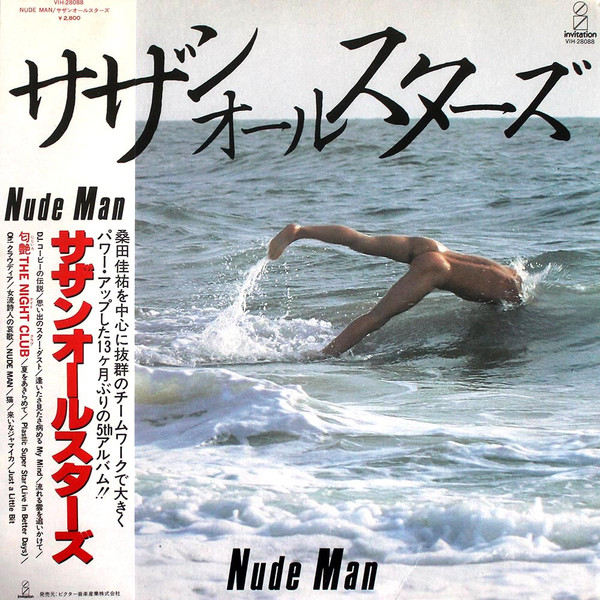- Tokyo Rush ⭐⭐⭐⭐⭐
- Shimendoka ⭐⭐⭐⭐⭐
- Japanese Rhumba⭐⭐⭐
- Asatoya Yunta⭐⭐⭐⭐
- Fujiyama Mama ⭐⭐⭐
- Femme Fatale⭐⭐⭐⭐
- Shambhala Signal⭐⭐
- Worry Beads⭐⭐⭐⭐⭐
- Paraiso ⭐⭐⭐⭐
Tuesday, January 31, 2023
Haruomi Hosono - Paraiso (1977)
Monday, June 20, 2022
Deadly Drive by Ginji Ito (1977)

THE MUSIC
THE VERDICT
Wednesday, March 2, 2022
The 14th Moon by Yumi Arai - 1976
THE MUSIC
THE VERDICT ⭐⭐⭐⭐The 14th Moon veers away from the Tapestry-esque style of Hikoki Gumo and Muslim and has a brighter, Middle of the Road (MOR) sound. Many songs have added brass & string orchestration on top of the rich backing vocals that give it a sound closer to something from The 5th Dimension or The Carpenters. That being said Yuming's signature interpersonal songwriting is still at work here, covering everything from getting over breakups, to college students dealing with love affairs, even getting over your dog dying. Songs like the opening track, Sazanami, and Sunshower offer breezy sunshine pop sound akin to the works of Sugar Babe. The title track 14th Moon dives into some cool piano rock ala, Elton John or Billy Joel. Chuo Freeway is a funky jazz-pop track about driving on the real-life Chuo Expressway. In the Morning Light and Like Nothing Ever Happened have got all the tropes of a signature Yuming ballad. It has sad lyrics, beautiful melodic piano backed by an orchestration, and it's been covered to death by everyone else. In the Morning Light is probably one of my favorite Yuming songs, especially the way the song progressively becomes a power ballad with the build up of the drums and orchestral arrangement. A Summer Place takes a detour from Tokyo to Chigasaki, as we get a tropical samba dance number perfect for a beach party. Overall, The 14th Moon was a great way to cap off Yumi Arai's bachelorette years. It's a pretty standard 70's Adult Contemporary album, most comparable to something like Now & Then by The Carpenters or Olivia Newton-John’s Don't Stop Believin'. Which feels appropriate considering both features a marriage between the producer and lead singer. Unlike those albums, The 14th Moon has the added benefit of Yuming's knack for composing & writing catchy, original, and relatable songs. The 14th Moon is a must-have if you want to experience Yumi Arai at her best. |
Monday, March 22, 2021
Sunshower by Taeko Ohnuki -1977
THE HISTORY
After the breakup of Sugar Babe in 1976, Ohnuki had moved on to Crown Records, under the Panam label, specialized in releasing folk and New Music (precursor to city pop) records. She released Grey Skies that same year, however, it was mostly an extension of the sound produced by Sugar Babe, as it features many of their unused songs. For her next album, Ohnuki wanted to focus on creating a jazz-fusion sound, which was starting to gain traction in Japan during that time.
In order to accomplish this, the album features some major players in the genre. Then up-and-coming session musician, Ryuichi Sakamoto (坂本 龍一), was chosen as the arranger for the album. On bass, the album features Harry Hosono (細野晴臣) and Tsugutoshi Gotō (後藤 次利). On guitar, there's Shigeru Suzuki (鈴木茂), Koichi Hara (原浩一), Kenji Omura (大村憲司), and Kazumi Watanabe (渡辺 香津美). On drums, they got Tatsuo Hayashi (林立夫) as well as American musician Christopher Parker, from the band Stuff, who they met after watching their performance at the Rolling Coconut Review in Tokyo. Even Ohnuki's old band member, Tatsuro Yamashita, provides backing vocals for the album.
Apparently, the record company did not have much faith in Ohnuki's project or new direction. But, with the help and support of Sakamoto, she persisted to go all out on this album, drawing influences from artists like Stevie Wonder and Todd Rundgren, combining it with her personal life experiences growing up in the Suginami Ward of Tokyo, to create catchy but introspective songs. Sunshower was released on July 25th, 1977, and compared to her first album, sales were lackluster. However, that didn't stop the album from being recognized as a J-Pop classic in the coming decades.

THE MUSIC
Side A
- Summer Connection: ⭐⭐⭐⭐⭐
- Sunshine Pop in its purest form. A jazzy, uplifting track with cheerful horns, groovy bass, and an uplifting string arrangement, celebrating the season of the sun. The single cut of this song has a faster tempo and more lively drums.
- Kusuri wo Takusan (くすりをたくさん)| A Lot of Medicine: ⭐⭐⭐⭐
- A song that criticized the over-prescription of medicine, which is surprising when you consider how upbeat and cheerful it is, with its joyful flute playing against a mellow samba beat.
- Nani mo Iranai (何もいらない) | I don't need anything: ⭐⭐⭐⭐
- The song begins with some ominous violins, followed by a deep bass drop to set the tone of this soulful tune about rejecting the environment around you and wanting to escape. The highlight of this song is again the groovy bassline and the classy smooth jazz guitar solo.
- Tokai (都会) | City: ⭐⭐⭐⭐⭐
- A breezy melancholy track about feeling trapped in the mundane cycle of city living. Another mellow smooth jazz arrangement featuring highlights like the stellar synthesizer solo, smooth saxophone, and the ethereal, occasionally eerie backing vocals.
- Karappo no Isu (からっぽの椅子) | Empty Chair: ⭐⭐⭐⭐
- A sad & bluesy jazz ballad about being overcome with loneliness. This song was originally part of Sugar Babe's repertoire and was sung at their final concert in 1976.
Side B
- Law Of Nature: ⭐⭐⭐
- A soft rock composition inspired by Todd Rundgren's Utopia that explores Man's relationship with mother nature.
- Dare no Tameni (誰のために) | For Whom: ⭐⭐⭐⭐
- Another Latin influenced track about vulnerability and marginalization through lack of prestige.
- Silent Screamer: ⭐⭐⭐⭐
- This song is about the desire to escape, too and it's strong that an image of driving a car at a breakneck speed. According to Ohnuki, back then, the energy was quite full and at least in the music, she wanted to run wild.
- Sargasso Sea: ⭐⭐⭐⭐
- The unique space age-ambient theme of the mystical Sargasso Sea. The creative use of synthesizers and short piano melodies, help create a futuristic, yet nautical atmosphere of wanderlust.
- Furiko no Yagi (振子の山羊) | Pendulum of Capricorn: ⭐⭐⭐⭐⭐
- The finale composed by Ryuichi Sakamoto begins with a symphonic intro, that leads into a progressive jazz-rock ballad where Ohnuki's ghostly vocals describe the end of days for humankind and its eventual reincarnation. The song ends on a funky piano breakdown, accompanied by an epic, bluesy guitar solo as the song fades out until the final thing heard is Ohnuki stating "山羊は その枝を食べた /The goat ate the branch".
THE VERDICT
 This brings up an astonishing realization; this is the most anti-city city pop album I've ever heard! Most of the songs are cover the societal problems that come with living in the streets in Tokyo, from over-medication to depression, to obligatory social status, to more heavy topics like man's relationship with nature and existential dread. Yet it's all wrapped in soothing melodies with jazzy pianos, melodic guitar solos, mesmerizing backing vocals, and psychedelic synthesizers. On top of that, Ohnuki's soft, innocent, and ethereal voice really makes you forget that she's singing about the end of all existence by the end of the record. It all starts to make sense when you learn about Taeko Ohnuki's upbringing in Tokyo, and how the post-war economic boom shaped her struggles surviving in the constantly evolving metropolis. I'm pretty confident that Summer Connection is the only happy song on the album, which isn't a bad thing since, despite the lyrical tone shift, the album retains the same breezy and whimsical vibe established by the opening number.
This brings up an astonishing realization; this is the most anti-city city pop album I've ever heard! Most of the songs are cover the societal problems that come with living in the streets in Tokyo, from over-medication to depression, to obligatory social status, to more heavy topics like man's relationship with nature and existential dread. Yet it's all wrapped in soothing melodies with jazzy pianos, melodic guitar solos, mesmerizing backing vocals, and psychedelic synthesizers. On top of that, Ohnuki's soft, innocent, and ethereal voice really makes you forget that she's singing about the end of all existence by the end of the record. It all starts to make sense when you learn about Taeko Ohnuki's upbringing in Tokyo, and how the post-war economic boom shaped her struggles surviving in the constantly evolving metropolis. I'm pretty confident that Summer Connection is the only happy song on the album, which isn't a bad thing since, despite the lyrical tone shift, the album retains the same breezy and whimsical vibe established by the opening number.Saturday, March 20, 2021
Mignonne by Taeko Ohnuki -1978
THE HISTORY
THE MUSIC
SIDE B
THE VERDICT |
Then you get more unique songs like Jaja Uma Musume, while funky and catchy, seem a bit outside of Ohnuki's comfort zone, from a lyrical standpoint mostly, since I don't think Ohunki has a shrewd personality and her voice doesn't really carry the authority to back up what she's saying. This feels like something, you would hear from Minako Yoshida or Junko Ohashi's discography. Can't Get the Words Out is another great disco track with an uplifting melody that feels more in line with Ohuki's style. Then there's the best track, 4:00am., I remember when I first heard it being entranced by the suspenseful flute in the intro and being hooked by the gospel-style choir chanting "Lord give me one more chance!".
Friday, February 28, 2020
ALBUM REVIEW: SONGS By Sugar Babe 1975

Sugar Babe was a soft rock band formed in Tokyo, Japan in 1973 and split up in 1976. The core of the band featured the pre-solo debut of Tatsuro Yamashita (山下達郎 ), Taeko Ohnuki(大貫妙子), & Kunio Muramatsu (村松邦男). The group made its live performance debut in 1973 at the farewell concert for the rock group Happy End. Now there were a lot of one-off bands during the 70s’, however, what made them stand out was their music style. They were perhaps one of the first Japanese rock bands to use the Major 7ths & Broken chords, which made the music extremely different from the pop of that time period. While their contemporaries were hard rockers, Sugar Babe focused on playing melodic, well-crafted tunes heavily influenced by American pop from the ’60s and ’70s and soul music. Coupled with romanticized lyrics about city life, all these elements lead to the creation of their debut album, SONGS, which laid the groundwork for what would later be known as City Pop.
 |
FROM THE LEFT: Kunio Muramatsu, Taeko Ohnuki, Kikuo Wanikawa, Tatsuro Yamashita, Akihiko Noguchi
|
The initial debut lineup of the band was Yamashita, Ohnuki and Kunio on vocals (and many instruments), Kikuo Wanikawa(鰐川己久男)on bass, Makoto Kimura (木村誠) on percussions, and Akihiko Noguchi(野口明彦)on drums. Although there were changes made during the actual recording of the album and the final year of Sugar Babe's existence, which included the inclusion of Ginji Ito(伊藤銀次)on guitar, and Kikuo & Akihiko Being replaced by Yuasa Uehara (上原裕) & Jiro Terao (寺尾次郎) on drum & bass respectively. Sugar Babe also had some veteran help from the likes of former Happy End front-man Eiichi Ohatki, who was the producer & mixer of the album, and Fumiyo Nunoya on backing vocals, who was the lead singer of the hard rock group, Blues Creation. The cover of the album was designed by Tatsuya Kaneko (金子辰也), whose art is a recreation of a photo of two women from a Photography Book published in 1954 called Women of Paris, by Nico Jesse & André Maurois.
 |
FROM THE LEFT: Tatsuro Yamashita, Taeko Ohnuki, Yuata Uehara, Kunio Muramatsu, & Jiro Terao
|
The recording of the album started October 28, 1974, and lasted until March 7th of 1975. SONGS was released on the 25th of April, 1975, as the flagship release of Ohtaki's Niagara label, which was a sub-label of Elec Records, one of the first Japanese independent labels. The reception of the band was mostly negative from the mainstream, outside of the niche crowd of college students, which apparently included a young, pre-debut Mariya Takeuchi. With no other bands of the same style, they received a lot of irrational criticism and silly slander. In an interview with Red Bull Academy, Ohunki recalls one concert where Sugar Babe played, the audience started throwing trash and bottles at them, being screamed at and called “a bunch of cicadas” whenever they sang. The band broke up in 1976, due in part to the bankruptcy of their record label, and also the fact they grew apart musically. Yamashita, Muramatsu, and Ohnuki went on to have long and successful careers and would use much of the material they had initially written for a second Sugar Babe album, for their respective debut albums, Ohnuki with Grey Skies (1976), Muramatsu with Green Waters (1983), and Yamashita with Circus Town (1976).
 |
Sugar Babe Alongside their producer, Eiichi Ohtaki
|
 |
Sugar Babe in Live
|
- SHOW: This almost Broadway Revue-style intro serves as the perfect beginning to the album, the highlight being the vocal breakdown at the end reminiscent of the Four Seasons.
- DOWNTOWN: And here it is, what’s basically ground zero for literally all City Pop music. Combining the bright surf rock-esque guitars, with the funky drums & clavinet beat reminiscent of the Isley Brothers, to create the perfect anthem for a lively Saturday night.
- Mirage Town (Shinkirou no Machi /蜃気楼の街): Taeko Ohnuki and her piano take the spotlight this time to give us a more mellow look at being in the city.
- World of Wind (Kaze no Sekai/ 風の世界): Another one of Taeko’s introspective songs, this time about feeling lonely in an empty city.
- Always Sighs (Tameiki Bakari/ためいきばかり): A bouncy tune about morning hangover blues written by Kunio Muramatsu that's equal parts bubble gum pop & country rock.
- As Usual (Itsumo Doori /いつも通り): A short mid-tempo upbeat tune about someone going about their unchanging life in the big city. The highlight being the awesome string arrangements during the chorus section.
- Lovely Melody (Suteki na Melody/すてきなメロディー): Probably the shortest and most unique song in the album. It’s an upbeat honky-tonk pop tune built around the chords of Pachelbel's Canon. It also features another interesting vocal breakdown, this time with...goat noises???
- Somehow Today (Kyou wa Nan daka/今日はなんだか): Probably the 2nd most iconic song Yamashita sings on this album. A high-tempo soft rock tune that almost reaches power ballad territory.
- The Rain Has Filled The Palms of My Hands (Ame wa Te no Hira ni Ippai/雨は手のひらにいっぱい): City Pop’s first official resort pop song, about a rainy day in the city. Complete with arrangements that are equal parts, B.J. Thomas & Phil Spector.
- Days Gone "60's Dream" (Sugi Sarishi Hibi/過ぎ去りし日々): The only acoustic track on the album by Yamashita himself. A nostalgic & sad song about a high-school relationship that didn’t last.
- SUGAR: The finale of the album that feels more like a jam session than a complete song. Still enjoyable nonetheless with its more Latin-based arrangements. The lyrics also feature a nice reference to "Sugar Town" by Nancy Sinatra.
 |
Track List from the Anniversary Release
|
THE VERDICT
Production: ⭐⭐⭐⭐
Vocals:⭐⭐⭐⭐
Arrangement:⭐⭐⭐
Aesthetic:⭐⭐⭐
Memorability: ⭐⭐⭐
Composition:⭐⭐⭐⭐
 |

 |
| Sugar Babe Reunion! (Minus Tatsuro Yamashita 😟 ) |
Nude Man by Southern All Stars - 1982
Whenever I talk to Japanese tourists about Shōwa-era music, one band name comes up constantly: Sazan —better known by their full name, South...

-
I’m a firm believer that good music is something that transcends the boundaries of both time and culture. That especially holds true wh...
-
All the photography for this album was done in Hawaii A few days ago before the time I write this review, Spotify had just release...
-
Some of the most influential bands are the ones that work behind the scenes. They are usually in the form of session musicians but they'...
















